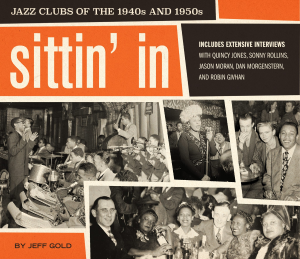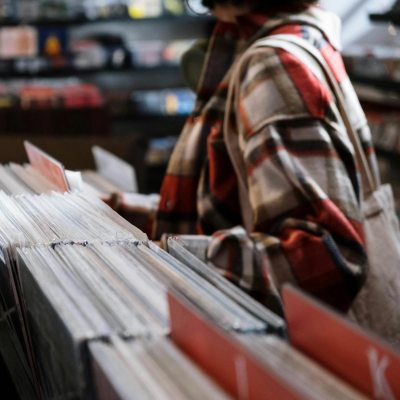.
.
…..Jeff Gold’s book Sittin’ In: Jazz Clubs of the 1940s and 1950s is a visual history of many of the country’s most influential night clubs and ballrooms during jazz music’s golden era.
…..The book is centered around a collection of memorabilia Mr. Gold discovered, and features photographs of club patrons taken by in-house photographers, as well as postcards, handbills, menus, matchbooks, and posters.
…..In cooperation with Mr. Gold, Jerry Jazz Musician will occasionally publish a noteworthy excerpt from the book. In this edition, Gold writes about New York’s Midtown Manhattan club Birdland, and shares photographs and memorabilia from his collection.
.
.
___
.
.
Birdland
1678 Broadway, Just North of West Fifty-Second Street
.
.
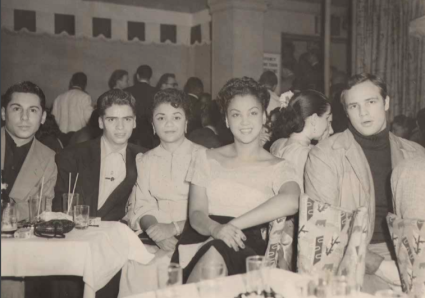
Birdland souvenir photograph with frequent patron Marlon Brando (right) posing with clubgoers, date unknown
.
___
.
…..
…..On December 15, 1949, former [midtown Manhattan jazz club] Royal Roost partner Morris Levy opened Birdland with his brother Irving, manager Oscar Goodstein, and six other partners. The three-hundred-seat basement club, named in honor of bebop giant Charlie “Bird” Parker, opened with A Journey thru Jazz 1920-1950, showcasing the history of jazz as played by some of those who had created it: trumpeters Max Kaminsky and Hot Lips Page, up-and-comers Stan Getz and Lennie Tristano, Lester Young, Harry Belafonte, and Parker.
…..Birdland historian Leo T. Sullivan wrote, “Many jazz clubs opened and closed over the many years, but never has there been a venue showcasing such incredible jazz greats on a nightly basis as the ‘Jazz Corner of the World,’ Birdland.”
…..The club featured a long bar on one side, booths on the other, and tables running down in the middle. Above the booths were portraits of jazz stars painted by Diana Dale, the club’s hatcheck girl. For those too young to drink or who came only to listen, there was the “bullpen” or “peanut gallery,” a section to the right of the bar separated from the rest of the club by a barrier. When the club first opened, there were birdcages with live finches hanging from the ceiling; unfortunately, the noise and smoke proved too much for the birds, who lasted only about a month.
…..Birdland didn’t have a dance floor, and the stage was small enough that on occasion, if a large group was playing, the piano was placed on the floor. Nearby was a radio booth where Symphony Sid broadcast nightly to listeners on the East Coast, from midnight until six o’clock in the morning. Pee Wee Marquette, standing three feet, nine inches tall, was the clubs notorious emcee, most famous for intentionally mispronouncing the name of any performer who refused to tip him.
…..Birdland booked top acts for six-night runs, with Mondays reserved for jam sessions. As one of the main bebop venues, the club played host to Parker as well as Bud Powell, Thelonious Monk, Dizzy Gillespie, and Miles Davis. Count Basie, a favorite of Morris Levy’s, made Birdland his New York base of operations and signed to Levy’s record label, Roulette, in the late 1950s. The club did well with women vocalists, booking Billie Holiday, Nina Simone, Ella Fitzgerald, and Dinah Washington. Other musicians who appeared included Clifford Brown, Sonny Rollins, Art Tatum, Duke Ellington, Lester Young, Stan Getz, and Dave Brubeck. George Shearing wrote the standard “Lullaby of Birdland” after Levy asked him to compose a theme song for Symphony Sid’s broadcasts.
…..As the club’s popularity grew, it became a draw for celebrities; patrons included Marilyn Monroe, Marlene Dietrich, Frank Sinatra, Ava Gardner, Judy Garland, Sugar Ray Robinson, and even classical music icon Igor Stravinsky. Eventually the Birdland name gained enough cachet that the club was able to sponsor national – and, in at least one case, international – concert tours during the mid-to late 1950s.
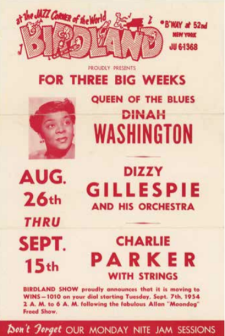
Birdland handbill for 1954 triple-bill featuring Dinah Washington, Dizzy Gillespie, and Charlie Parker
…..While Levy was committed to integration and Birdland an oasis of sorts from racism, things could be different just outside the door. On August 15, 1959, Miles Davis, who was performing with his quintet at the club, stepped outside to take a break. In his autobiography, Davis recalled: “I had just walked this pretty white girl named Judy out to get a cab. She got in the cab, and I’m standing there in front of Birdland wringing wet because it’s a hot, steaming, muggy night in August. This white policeman comes up to me and tells me to move on…’Move on, for what? I’m working downstairs. That’s my name up there, Miles Davis,’ and I pointed my name on the marquee all up in lights. He said, ‘I don’t care where you work, I said move on! If you don’t move on I’m going to arrest you.’ I just looked at his face real straight and hard, and I didn’t move. Then he said, ‘You’re under arrest!’
…..A fight ensued, with Davis badly beaten by three officers before being hauled off to jail, charged with disorderly conduct and the assault of a police officer. The story was widely reported, with photographs of a bloodied Davis, and eventually the charges were dropped, but Davis never forgot the incident. “[It] changed my whole life and my whole attitude again, made me bitter and cynical again when I was really starting to feel good about the things that had changed in this country.”
…..Many legendary live albums were recorded at the club, including Art Blakey’s two-volume A Night at Birdland (1954), Count Basie’s Basie at Birdland (1961), and most of John Coltrane’s Live at Birdland (1964). But as rents in the area rose, running a profitable jazz club became increasingly difficult, and in June 1964, Birdland filed for Chapter 11 bankruptcy, closing for good the next year.
…..The club’s legacy was boosted in 1977 by Josef Zawinul’s song “Birdland,” featured on his band Weather Report’s bestselling album Heavy Weather. In 1980, the Manhattan Transfer’s version of the song won a Grammy Award, and in 1991, Quincy Jones’s version won two more. In 1986, a new club with the Birdland name opened in the midtown theater district.
.
.
___
.
.
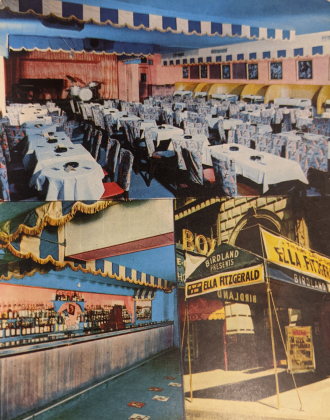
Birdland postcard, 1950s
.
.
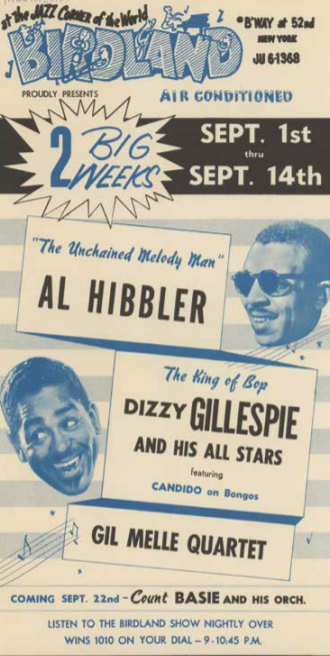
Birdland handbill for a 1955 engagement with Al Hibbler, Dizzy Gillespie, and Gil Melle
.
.
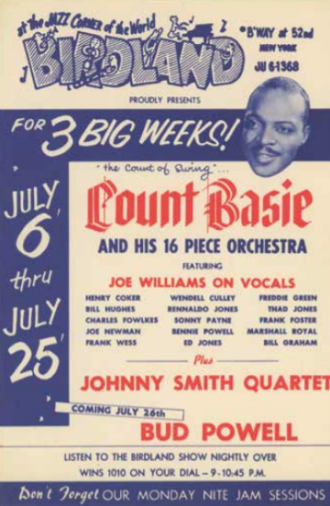
Handbill advertising 1956 Birdland shows with Count Basie, Johnny Smith and Bud Powell
.
.
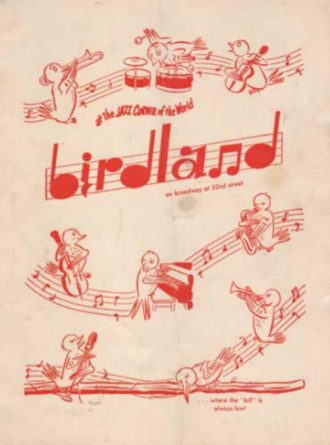
Birdland menu, date unknown
.
.
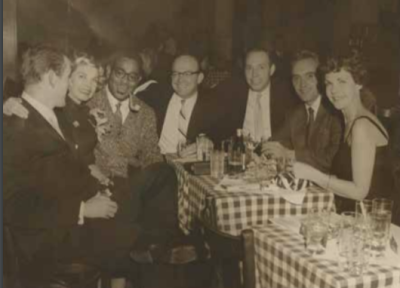
Birdland souvenir photograph with Dizzy Gillespie posing with fans, date unknown
.
.
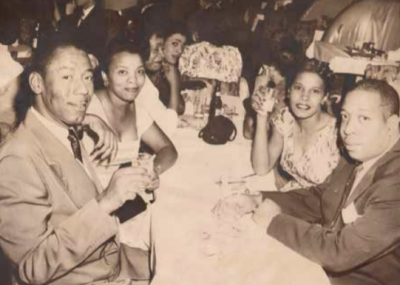
Birdland souvenir photograph, date unknown
.
.
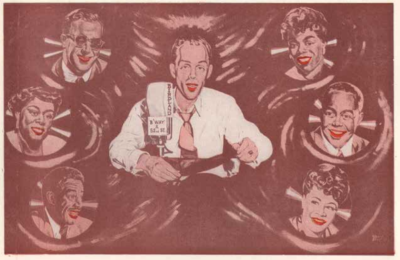
Jazz DJ Symphony Sid pictured on the inside of a Birdland photo folder along with other notable jazz figures.
.
.
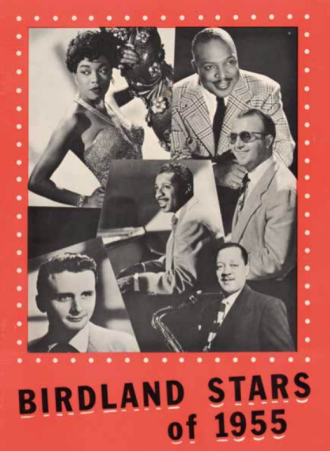
Concert tour program, 1955
.
.
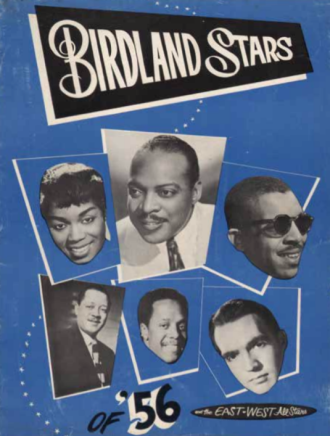
Concert tour program, 1956
.
.
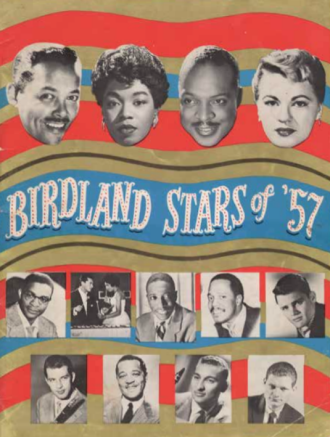
Concert tour program, 1957
.
.
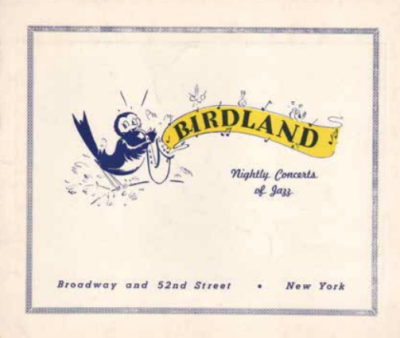
Birdland photo folder, date unknown
.
.
___
.
.
Listen to a 1954 recording of Sarah Vaughan (with Clifford Brown on trumpet) singing George Shearing’s composition “Lullaby Of Birdland.”
.
.
Listen to the 1977 recording of Weather Report playing Josef Zawinul’s composition “Birdland”
.
.
___
.
.
Click here to read Vol 1, on the Savoy Ballroom
Click here to read Vol 2, on Birdland
Click here to read Vol 3, on Club Ubangi
Click here to read Vol 4, Four Harlem Nightspots
Click here to read Vol 5, on Connie’s Inn and Smalls’ Paradise
.
Click here to read our interview with Jeff Gold
.
.
___
.
.
photo courtesy Jeff Gold

Jeff Gold is a Grammy Award-winning music historian, archivist, author, and executive. Profiled by Rolling Stone as one of five “top collectors of high-end music memorabilia,” he is an internationally recognized expert who has consulted for the Rock & Roll Hall of Fame, Museum of Pop Culture, and various record labels and cultural institutions. He has also appeared as a music memorabilia expert on PBS’s History Detectives and VH1’s Rock Collectors. His other books include 101 Essential Rock Records: The Golden Age of Vinyl from the Beatles to the Sex Pistols and Total Chaos: The Story of the Stooges/As Told by Iggy Pop. He own the music memorabilia website Recordmecca.com and writes about topics of interest to collectors on its blog.
Follow Jeff on Twitter at @recordmecca or on Instagram at @recordmecca.
.
.
___
.
.
All text and images — unless otherwise noted — © Jeff Gold. Excerpted from Sittin’ In: Jazz Clubs of the 1940s and 1950s (Harper Design). Published by permission of Jeff Gold.
.
.
.




